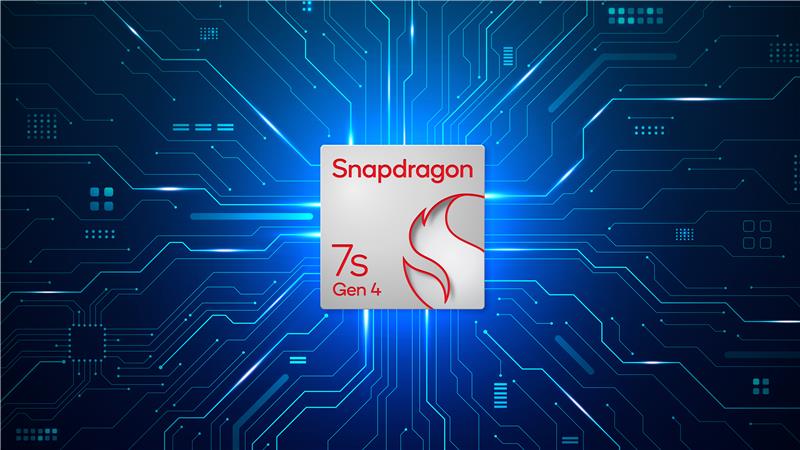The mid-range smartphone market is one of the most competitive segments in the mobile industry. Users expect performance, gaming, AI features, and premium experiences without spending flagship-level money. To cater to this demand, Qualcomm has introduced its latest silicon, the Snapdragon 7s Gen 4, launched in mid-August 2025. Positioned as a refined sibling to the Snapdragon 7 Gen 4, this chipset blends flagship-inspired features into a more accessible package.
The Snapdragon 7s Gen 4 may not be a revolutionary upgrade, but it manages to stand out with balanced improvements across CPU, GPU, gaming, AI, imaging, and connectivity. In this blog, we’ll take a deep dive into everything that makes this chipset special, and why it could power some of the most popular mid-range devices in the coming year.
Performance: Incremental but Meaningful Boost
While the Snapdragon 7s Gen 4 doesn’t radically transform performance, it offers a 7% boost in both CPU and GPU capabilities compared to its predecessor, the Snapdragon 7s Gen 3. This bump makes a noticeable difference in real-world tasks, especially for users upgrading from older mid-range devices.
At the heart of the chipset is a tried-and-tested 1+3+4 Kryo CPU configuration, built on TSMC’s 4nm process. The layout consists of:
- 1x Cortex-A720 Prime Core clocked at 2.7 GHz
- 3x Cortex-A720 Performance Cores running at 2.4 GHz
- 4x Cortex-A520 Efficiency Cores at 1.8 GHz
The jump from 2.5 GHz to 2.7 GHz on the Prime core is the main driver of this uplift, ensuring smoother multitasking, faster app launches, and more reliable performance under load.
On the graphics side, the upgraded Adreno GPU also delivers a parallel 7% increase, enabling smoother visuals and better handling of modern gaming demands. While the performance gains may seem modest on paper, the efficiency and consistency improvements make this chip a compelling option in the mid-range bracket.
Gaming: Bringing Elite Features to the Masses
Gaming is one of the strongest highlights of the Snapdragon 7s Gen 4. Qualcomm has introduced features usually seen in higher-end chips, giving gamers on a budget access to advanced technologies.
- Snapdragon Game Super Resolution: This AI-driven upscaling tool enhances visual fidelity in games without overwhelming the GPU, balancing sharpness and fluid gameplay.
- Adaptive Performance Engine 3.0: Optimizes thermal management and GPU workloads, ensuring stable frame rates even during extended gaming sessions.
However, Qualcomm has left out Adaptive Performance Engine 4.0, keeping it exclusive to higher-tier processors. Still, the 7s Gen 4 strikes a sweet spot, offering serious gaming power in a mid-tier device.
Display: High Refresh Meets High Resolution
Another area where the Snapdragon 7s Gen 4 shines is display support. It can drive WFHD+ displays at up to 2,900 × 1,300 pixels with refresh rates as high as 144 Hz.
This makes the chip future-ready for smartphones with high-refresh panels and even handheld gaming devices. The combination of sharp resolution and ultra-smooth refresh rates enhances everything—from fast-paced gaming to scrolling through social media. HDR10 and HDR10+ support further elevate multimedia consumption, ensuring brighter highlights and deeper contrasts.
AI Capabilities: Smart Features, On-Device
Artificial Intelligence is no longer a luxury feature—it’s a necessity in modern smartphones. The Snapdragon 7s Gen 4 integrates Qualcomm’s Hexagon NPU, enabling on-device AI tasks that enhance user experience without relying on the cloud.
It supports lightweight language and vision models like Llama 1B and Qwen 1B, powering use cases such as:
- Real-time translation for travelers and global users
- On-device transcription for meetings, classes, and voice notes
- Noise cancellation and background suppression for clear calls and recordings
The advantage of on-device AI is privacy, speed, and reliability, making mid-range phones more capable than ever before.
Imaging and Video: AI Meets Creativity
Smartphone photography remains one of the most important factors for buyers. Qualcomm ensures the Snapdragon 7s Gen 4 keeps up with expectations, offering features that rival premium chips:
- Support for up to 200 MP photo capture
- AI Remosaic to intelligently improve detail and clarity
- Video Super Resolution for sharper, stabilized video recording
- 4K HDR video capture at 30 fps, complete with HDR10 and HDR10+ standards
For mid-range phones, these specs are impressive. They allow brands to deliver professional-grade photography and videography experiences without raising device prices dramatically.
Connectivity: Future-Ready Networking
Connectivity is another strong suit of this chipset. It features Qualcomm’s modern networking suite with:
- 5G support across both mmWave and sub-6 GHz bands
- Wi-Fi 6E for faster, lower-latency wireless internet
- Bluetooth 5.4 for stable and energy-efficient audio and accessory connections
- Qualcomm FastConnect technologies for enhanced consistency
Memory and storage also get a premium touch, with support for LPDDR5 RAM (up to 16 GB) and UFS 3.1 storage, ensuring smooth multitasking and quick file access.
Battery and Charging: Speed and Efficiency
No performance boost would matter without efficient power management. Qualcomm balances this with:
- Quick Charge 4+: Capable of charging up to 50% in just 5 minutes
- TSMC’s 4nm efficiency: Helps conserve battery during demanding tasks
On the audio front, Qualcomm’s Aqstic codec with aptX Lossless ensures premium music playback quality—an often overlooked yet important feature for audiophiles.
Debut Device: Redmi Note 15 Pro+
To showcase its capabilities, Qualcomm has partnered with Xiaomi. The first phone to feature the Snapdragon 7s Gen 4 is the Redmi Note 15 Pro+, launching in China on August 21, 2025.
This collaboration underscores Xiaomi’s strategy of pushing innovation into the mid-range segment, while also giving Qualcomm’s new chip a real-world platform to prove its power. More smartphone brands are expected to adopt the 7s Gen 4 soon, making it a key player in devices rolling out later this year.
Spec Sheet at a Glance
| Feature | Specification |
|---|---|
| CPU Architecture | 1× Cortex-A720 @ 2.7 GHz; 3× Cortex-A720 @ 2.4 GHz; 4× Cortex-A520 @ 1.8 GHz |
| Manufacturing Process | TSMC 4nm |
| Performance Uplift | ~7% CPU & GPU |
| GPU | Upgraded Adreno (~7% faster) |
| Gaming Features | Game Super Resolution; Adaptive Performance Engine 3.0 |
| Display Support | WFHD+ up to 2,900 × 1,300 @ 144 Hz, HDR10+ |
| AI Support | Llama 1B, Qwen 1B; real-time translation, transcription, noise suppression |
| Camera & Video | Up to 200 MP capture, AI Remosaic, 4K HDR @ 30 fps |
| Connectivity | 5G (mmWave + sub-6 GHz), Wi-Fi 6E, Bluetooth 5.4 |
| RAM & Storage | LPDDR5 up to 16 GB; UFS 3.1 |
| Charging | Quick Charge 4+ (0–50% in 5 min) |
| Audio | Aqstic codec, aptX Lossless |
Who Should Care About the Snapdragon 7s Gen 4?
- Gamers on a budget: High-refresh displays, GPU improvements, and Game Super Resolution bring smooth, console-like gaming to affordable phones.
- Content creators and media lovers: 200 MP camera support and 4K HDR video ensure stunning captures.
- Power users: With up to 16 GB RAM and strong AI tools, multitasking and productivity see a boost.
- Global consumers: With advanced 5G and Wi-Fi 6E, this chip ensures connectivity isn’t a bottleneck.
Conclusion
The Snapdragon 7s Gen 4 may not break performance records, but it embodies Qualcomm’s philosophy of “flagship trickle-down.” By delivering thoughtful, incremental upgrades in gaming, AI, imaging, and connectivity, this chip successfully redefines what users can expect from mid-range smartphones.
With its debut on the Redmi Note 15 Pro+ and the likelihood of adoption across multiple brands, the Snapdragon 7s Gen 4 could very well become the go-to choice for consumers who want premium features without premium pricing.
It’s not just a chipset—it’s a statement that the mid-range is the new mainstream.

